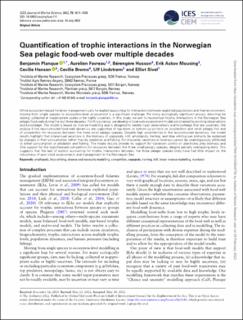| dc.contributor.author | Planque, Benjamin | |
| dc.contributor.author | Favreau, Aurelien | |
| dc.contributor.author | Husson, Berengere | |
| dc.contributor.author | Mousing, Erik Askov | |
| dc.contributor.author | Hansen, Cecilie | |
| dc.contributor.author | Broms, Cecilie | |
| dc.contributor.author | Lindstrøm, Ulf Ove | |
| dc.contributor.author | Sivel, Elliot Manuarii | |
| dc.date.accessioned | 2023-03-07T09:19:24Z | |
| dc.date.available | 2023-03-07T09:19:24Z | |
| dc.date.created | 2022-12-16T13:21:13Z | |
| dc.date.issued | 2022 | |
| dc.identifier.citation | ICES Journal of Marine Science. 2022, 79 (6), 1815-1830. | en_US |
| dc.identifier.issn | 1054-3139 | |
| dc.identifier.uri | https://hdl.handle.net/11250/3056322 | |
| dc.description.abstract | While ecosystem-based fisheries management calls for explicit accounting for interactions between exploited populations and their environment, moving from single species to ecosystem-level assessment is a significant challenge. For many ecologically significant groups, data may be lacking, collected at inappropriate scales or be highly uncertain. In this study, we aim to reconstruct trophic interactions in the Norwegian Sea pelagic food-web during the last three decades. For this purpose, we develop a food-web assessment model constrained by existing observations and knowledge. The model is based on inverse modelling and is designed to handle input observations and knowledge that are uncertain. We analyse if the reconstructed food-web dynamics are supportive of top-down or bottom-up controls on zooplankton and small pelagic fish and of competition for resources between the three small pelagic species. Despite high uncertainties in the reconstructed dynamics, the model results highlight that interannual variations in the biomass of copepods, krill, amphipods, herring, and blue whiting can primarily be explained by changes in their consumption rather than by predation and fishing. For mackerel, variations in biomass cannot be unambiguously attributed to either consumption or predation and fishing. The model results provide no support for top-down control on planktonic prey biomass and little support for the hypothesised competition for resources between the three small pelagic species, despite partially overlapping diets. This suggests that the lack of explicit accounting for trophic interactions between the three pelagic species likely have had little impact on the robustness of past stock assessments and management in the Norwegian Sea. | en_US |
| dc.language.iso | eng | en_US |
| dc.title | Quantification of trophic interactions in the Norwegian Sea pelagic food-web over multiple decades | en_US |
| dc.title.alternative | Quantification of trophic interactions in the Norwegian Sea pelagic food-web over multiple decades | en_US |
| dc.type | Peer reviewed | en_US |
| dc.type | Journal article | en_US |
| dc.description.version | publishedVersion | en_US |
| dc.source.pagenumber | 1815-1830 | en_US |
| dc.source.volume | 79 | en_US |
| dc.source.journal | ICES Journal of Marine Science | en_US |
| dc.source.issue | 6 | en_US |
| dc.identifier.doi | 10.1093/icesjms/fsac111 | |
| dc.identifier.cristin | 2094381 | |
| dc.relation.project | Norges forskningsråd: 276730 | en_US |
| dc.relation.project | Norges forskningsråd: 299554 | en_US |
| cristin.ispublished | true | |
| cristin.fulltext | original | |
| cristin.qualitycode | 2 | |
